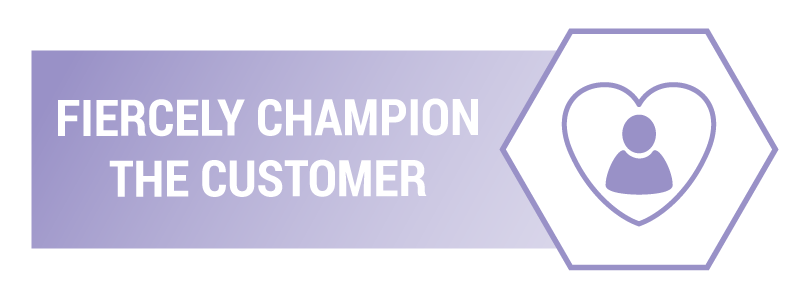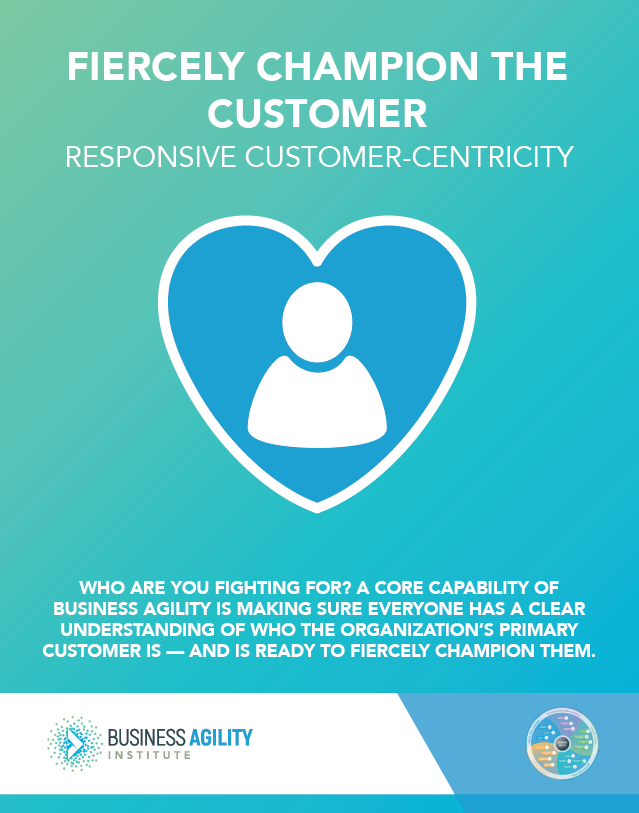Domains of Business Agility
- Responsive Customer-Centricity
- / Fiercely Champion The Customer
- / Sense & Respond Proactively
- / Integrate Diverse Ideas
- Engaged Culture
- / Cultivate A “Learning Organization”
- / Engage Transparently & Courageously
- / Embed Psychological Safety
- / Act As One
- Value-Based Delivery
- / Unleash Workflow Creatively
- / Prioritize. Prioritize. Prioritize.
- / Deliver Value Sooner
- / Seize Emergent Opportunities
- Flexible Operations
- / Adapt Strategies Seamlessly
- / Fund Work Dynamically
- / (Re)Organize Structures Fluidly
- / Balance Governance And Risk
- People-First Leadership
- / Foster Authentic Relationships
- / Empower With Accountability
- / Realize People’s Potential
Who are you fighting for? A core capability of business agility is making sure everyone has a clear understanding of who the organization’s primary customer is — and is ready to fiercely champion them.
Identifying and caring about your customer means making it personal. It means enriching your understanding of their values, their needs, and their expectations by listening, learning, and engaging with them. When organizations deeply understand what motivates and excites their customer — as well as what they aspire toward and struggle with — they can envision a bold new future for their customers that will inspire and resonate.
Primary Behaviors
The following 6 behaviors strongly contribute to the ability to fiercely champion the customer.
B01: Everyone proactively searches for opportunities to satisfy and delight the customer: “The Customer” plays a central role in all work in the organization. Plans, priorities, decisions, and actions all consider the impact on the customer. Will they be more or less satisfied or delighted by what we do? How can we amplify their delight? What new opportunities are we finding to wow our customers?
B02: Everyone deliberately crafts and iteratively refines the customer experience: Everyone in the organization understands the organization’s vision for the “Customer Experience” (how customers or potential customers perceive the business and its products/services, based on their interactions with the business, even if there is ultimately no purchase). Everyone considers how their work could affect the Customer Experience and works to make the Customer Experience progressively better.
B03: Everyone invests in an in-depth understanding of customer motivation: As part of a customer-centric organization, everyone works to understand the underlying needs or desires that drive potential customers to identify and purchase products or services like those of their organization.
B04: Leaders design governance processes to improve customer outcomes rather than back office efficiency: When implementing processes to manage and control the function of the business, leaders consider the impact of these governance processes on the customer. A good governance process - at a minimum - does not degrade customer outcomes. Ideally, a change in governance supports an improved customer outcome.
B05: Executives craft strategies that are impactful to customers (not just the company) while remaining aligned with the organization’s principles and purpose: Strategies focus on how our organization will create positive outcomes for customers in alignment with our mission, vision and values. We know that, as we create value for our customers, we will achieve our internal financial and growth objectives.
B06: Leaders behave as creative visionaries as well as operational leaders: Leaders of product and service development teams inspire and motivate the creativity of their teams by sharing their vision of what’s possible tomorrow, rather than just emphasizing today’s operations.


